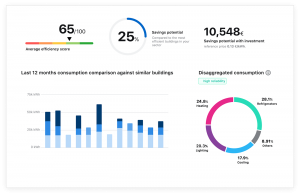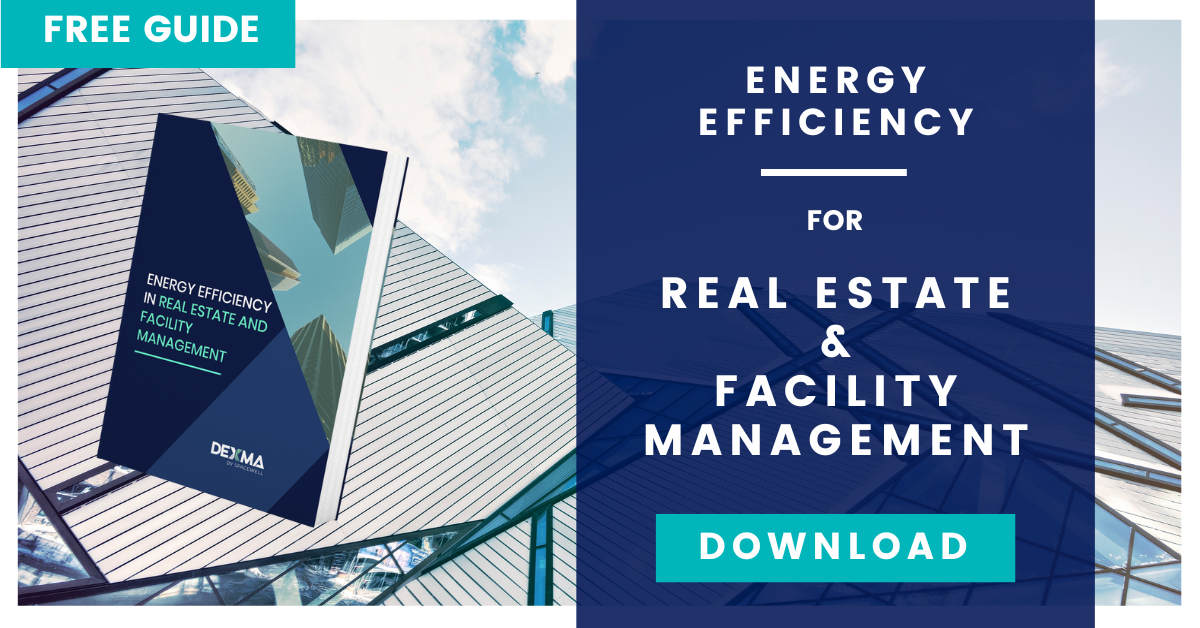When you work in Real Estate or Facility Management sector, and you are part of the energy management department, one of your challenges is to manage a multitude of locations, buildings and building portfolios of different types. This kind of work requires advanced energy management, and to be equipped with the right tools to achieve significant results.
Discover these 8 essential tools to carry out the advanced energy analysis your buildings need, achieve your company’s goals in energy saving and keep growing in your company thanks to the benefits achieved with your effort and work:
1. Analysis of Multiple Energy Sources
Your energy management technology must take into account ALL energy sources consumed in your properties.
If you choose a tool that is limited solely to the analysis of electricity you cannot minimise your costs and consumption of:
- Water
- Gas
- Thermal Energy
- Fuel tanks
- Biomass
You also cannot include in your analysis the impact of generation with renewables, which is an issue if your building portfolio has solar panels or geothermal technology, for example.
At Dexma, we are very aware of this. Therefore, our energy management technology for building portfolios provides advanced analysis tools for:
- Electricity
- Water
- Gas and thermal energy (you can see how we do this in this video or read this article on our support website). If you have any doubts about how to measure gas, this other article may help you.
- Fuel tanks
- Solar energy, thanks to our SolarView app.
- Biomass: there may be systems in the building that operate with biomass, for example, boilers (in this article you can see what biomass is and how to analyse it)
2. Calculating Associated Costs and Comparing them With Monthly Bills
The utility bills arrive at your buildings and properties with different frequencies. However, the financial manager wants to have an estimate of costs for this month (or quarter, or year) as soon as possible.
In addition, your colleague who is responsible for purchasing wants to be able to compare the bill received from the supplier with what was actually consumed.
How much work would this mean for you if you were to do this by reading the values from the meter, creating an Excel spreadsheet, downloading data from the platform of each utility company, etc.?
The ideal thing for real estate and facility management companies is to automatically generate a simulation of bills, with one click, for each building.
Therefore:
With Dexma, this simulation is generated on demand or automatically for the period that you determine.
And, as it is a multi-energy source platform, you can also generate it for water and gas.
This functionality is also ideal for helping you to retain your tenants and customers. It helps them to be prepared, to compare the bill from the utility company with their actual consumption, etc.
3. Calculating and Monitoring Energy Performance Indicator Ratios
What metrics do you use to find out whether your buildings are efficient? There are a number of energy ratios that may help you:
- Ratios by parameter. For example, in an office building, the ratio by floor in use.
- Constant ratio. In the same office building, this would be the ratio but calculated for the entire building. Regardless of its occupancy percentage.
- Ratio by date range. For example, employees of a company. This is a variable ratio that may increase or decrease by period.
Calculating and monitoring these indicators helps to standardise consumption and therefore discover which Energy Performance Indicators (EnPIs) or KPIs (Key Performances Indicators) are important for your company.
With Dexma, you can calculate and activate unlimited EnPIs. But what can you use them for? Some examples are benchmarking the consumption KPI divided by surface area and degree day to know whether your buildings in London are more or less efficient than those in Manchester. Or maybe your tenants or customers would like to know what energy they consume per employee.
Another challenge that the facility manager or owner of buildings finds 99.999999% of the time is ensuring the proper functioning of the global HVAC system. How can this be done? The key here is to be able to create performance reports using regression.
These reports calculate the regression between the outside temperature and the consumption of the HVAC system for a given period, for the cooling and heating zones. The reference temperatures set for the location are taken as the base. Inefficiencies or anomalies are quickly detected in this way.
With Dexma these reports are created on demand (whenever you want and need them) or based on a location.
4. Measurement and Verification with IPMVP Protocol
When you are a real estate or facility management company and you offer energy management services, how do you charge for them?
Most agreements usually have part of the remuneration linked to results. That is, to the savings you generate.
And how do you agree with a tenant or company about the value of the savings that you have generated? The IPMVP protocol is very useful in these cases. These initials stand for the International Performance Measurement and Verification Protocol. It was developed by the Efficiency Valuation Organization (EVO).
The key to the IPMVP protocol is that it proposes 4 measurement and verification options to apply in each of the energy improvements that you propose to your customers.
These measurement options allow you to verify the savings for each energy-saving measure, individually. That is, working by project.
In your specific case, the advantage of the IPMVP protocol is that it can reach the greatest level of detail. Wouldn’t it be interesting to be able to separately verify the savings after investing in solar energy and a new HVAC machine? And building by building across those in your portfolio?
With Dexma you can do this since it offers you a specific IPMVP module for monitoring energy saving by project or action.
Working with the protocol requires the creation of follow-up reports. As we have seen, with Dexma the reports are created on demand, with the configuration you need for your properties.
5. Cost & Consumption Forecasting
Do you remember how one of your challenges is to be able to “protect” yourself from the ups and downs of energy prices?
The possibility of predicting energy consumption (and cost) is the key to achieving this. And no, it isn’t magic. It’s mathematics, algorithms and having a powerful technological engine in the background that does the work for you.
Dexma has an advanced forecast module that allows you to forecast the consumption of your buildings based on different variables.
This function becomes even more important if we consider that it is increasingly expected that buildings will continue to have low energy consumption even in extreme weather conditions.
Extreme weather events are a concern for everyone managing buildings in areas where these frequently occur. Hurricanes, tornadoes, torrential wet seasons, and so on, will affect the operation of the building.
Using forecasting tools can help you make a building more resistant to extreme weather. In fact, in 2018, many analysts are saying that by 2050 buildings may be our first defence against extreme weather events.
This is of interest not only to the facility manager but also to the Finance Director who wants to be able to close their forecasts for cash, balance sheets, etc. as soon as possible. And if it is possible to “split hairs” and use figures that are as realistic as possible, then even better.
With an energy consumption forecasting tool, you will achieve this provided that:
- It is smart and proactive. It must be able to feedback with changes and be based on a model that learns the behaviour of the building.
- It works in real-time (with 4-hourly data).
Both features are available with Dexma.
6. Control of Consumption during Public Holidays and Outside Business Hours
What happens in your building when you’re not there? This is one of the biggest concerns of the facility manager.
If we think about an energy manager who is managing ten office buildings spread across several countries from a central office, the concern multiplies.
Thanks to technology, you no longer need to do the typical tour of the building to see what is happening. With real-time consumption monitoring and Dexma you can know what is happening wherever you are.
This advanced analysis will also help you retain your tenants. You can set up alerts that notify them when there is consumption in their office outside their working hours. Or create a customised report that tells them how much is consumed at weekends.
It is an “extra” value that you add to your services or your properties.
7. Calculation of the Carbon Footprint
We have already mentioned the legislative factor a couple of times. This is an important challenge for real estate and facility management companies.
Although responsibility for compliance with the law may not fall 100% on these companies, their customers are obliged to comply.
And the first person they are going to ask about how to do this is you, the person reading this guide.
Your energy management technology should be able to help you to:
- Convert the energy consumed into greenhouse gas emissions
- Propose emission reduction targets and track them in real time
- Generate reports on carbon emissions automatically (and that you can customise by building or customer).
At Dexma, a while ago we started examining the needs of all those who must comply with this type of law. Therefore, with Dexma you can analyse the emissions of all your buildings.
Click on the following image and we will take you to a video that tells you how to do it:
8. Customised Reports
As we have seen in some of the previous analysis capabilities, it is no use being able to do all of this if you do not communicate it.
The ability to generate customised reports through energy management software is vital for real estate and facility management companies.
First of all these reports are useful for your own team and company. This will help you to:
- Keep all your staff aligned
- Make the work you do more visible
If you like all the information you have found here today about the many tools you can use to manage the energy of each and every building in an advanced way as an energy manager in your real estate or facility management company, our special guide will help you much more:





